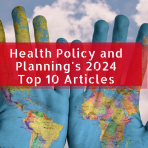Robert J. Montgomery1,2, Elaine Scudder2, Caitlin Tulloch2, Muna Jama2, Naoko Kozuki2 & Baris Ata1
- University of Chicago, Booth School of Business
- International Rescue Committee
Background
As more scrutiny is applied to foreign aid dollars, whether done carefully or carelessly, it becomes increasingly important that we correct the misconception that global health and humanitarian work lacks thoughtful and sophisticated decision making for the efficient use of the limited resources available to us. In our paper, we use constrained optimization to demonstrate one way to strengthen, document, and formalize decision-making processes.
Constrained optimization is a straightforward concept, and one that we often apply in our daily lives through various heuristics, whether written down or sorted out cognitively. It allows us to answer the question, what is the best decision I can make given the limited resources I have available? This is often a simple question (or at least a low-stakes one) when figuring out something like which recipe to use for cooking dinner when we take stock of our pantry and fridge, but can grow increasingly more difficult when deciding on things such as, in this case, which maternal and neonatal interventions to offer as part of a new community health program that will lead to the greatest number of projected lives saved.
For these more complex or consequential decisions, the formal approach to constrained optimization employed by engineers, economists and others is often appropriate. Organizing problems through this lens allows for the use of sophisticated algorithms to sort through unimaginably large combinations comprising possible solutions, but just as importantly, offering an organizing method for decision making with multiple stakeholders.
How cost-effective is it?
It is reasonable to question if cost-effectiveness ratios would be just as useful and more straightforward in evaluating which interventions to offer. However, considering this metric alone often fails to account for the additional constraints present beyond the financial budget available. For instance, in our paper we show that although neonatal resuscitation often appears high on (or even at the top of) lists for cost-effectiveness ratios for newborn care, it is not included in the optimal package of interventions for the Female Health Worker Program in Somalia. The model output makes clear that this is because of the longer curriculum time required to teach that intervention. Our model instead suggests that replacing neonatal resuscitation with several less individually impactful, but easier to teach interventions, will lead to more lives saved in our specific context. Ultimately, this approach forces the decision-makers to consider all of the steps necessary to deliver an intervention and acknowledges that interventions draw on multiple and often overlapping resources.
Implementation
In order to implement the model we have formulated, we held two workshops for designing maternal and neonatal community health programs, one each in Somalia and South Sudan. Fortunately, data sources, in our case the Lives Saved Tool, already exist that allow us to prepopulate some of the model parameters, and the workshops can focus on how interventions are delivered in these specific contexts. The constrained optimization approach requires stakeholders to agree on a single objective. In our case, we chose maximizing the number of maternal and neonatal lives saved as our objective function. After discussing the approach, the workshop attendees established all of the individual services we could offer and then defined the resources (in our paper, funds, time, commodities which can be procured, etc.) available and the budgets for each of these resources. The workshops then consisted of walking through each of the interventions and discussing how they would be provided so we can settle on the parameters used for each.
This detail-oriented approach which forces either agreement or specific instances of disagreement, which can be pinpointed to individual parameters, can help to head off impassible disagreements. For example, if there is a disagreement about how effective kangaroo mother care (KMC) is in preventing neonatal deaths due to prematurity, we are able to run the model two separate times, one each for the two levels of KMC efficacy presented by those in disagreement, to see if and how it changes the optimal package of interventions. If KMC appears in both optimal sets of interventions, then we can move forward knowing that it is the proper intervention to include, as long as its true efficacy falls within the range tested. If we find that the different parametric values used lead to different optimal packages of interventions, then we are able to further drill down on the uncertainty around this parameter. This focus changes the conversation from should we provide one intervention instead of another to the specific values used in the model and can help the conversations from losing this focus.
Conclusion
In this way, constrained optimization can serve both as an opportunity for showing one’s work throughout the decision-making process as well as a checklist to ensure that a structured process is followed in evaluating the resource requirements for offering specific services. We have begun to employ a similar model to the one presented in the paper to evaluate which services are best offered in emergency humanitarian response situations. We hope that our paper will encourage others to employ a similar approach in their decision-making processes.
Image credit: Louis Leeson/LSHTM











